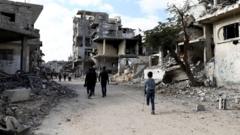On the first full day of peace in Gaza, rescue workers faced the staggering extent of destruction inflicted upon the region. Gaza's Civil Defence agency has warned that over 10,000 bodies may still be trapped under debris. The agency's spokesman, Mahmoud Basal, indicated their desire to recover the deceased within 100 days, hindered by a lack of necessary machinery.
Visual reports captured a landscape of ruin across Gaza following 15 months of Israeli offensives, particularly in northern areas. The United Nations previously assessed that approximately 60% of structures throughout Gaza were either damaged or obliterated. Although the cessation of air raids was celebrated, the circumstances for Gazans remain dire.
Over two million people in Gaza are now homeless, with many dependent on food assistance following the war, according to the UN World Food Programme (WFP). Following the ceasefire, aid trucks began pouring into Gaza, with reports stating that at least 630 lorries reached the region by the end of Sunday, and another 915 trucks arrived on Monday—marking the highest influx of assistance since fighting began.
Sam Rose, acting director of the UN's Palestinian refugee agency (Unrwa) in Gaza, highlighted that food and healthcare are only the start of the reconstruction process. He emphasized the need for the complete revitalization of communities that have endured profound trauma and suffering during the lengthy conflict.
As the situation evolves, families in Israel shared the mixed emotions surrounding the release of three hostages in an exchange aimed at paving the way for more negotiations. Israeli officials confirmed video footage of emotional reunions displayed a bittersweet side of their return to families, underlining broader issues of safety on both sides.
Palestinian health agencies report that casualty estimates have reached over 46,900 during the conflict, with many victims categorized as civilians, mainly women and children. A study published by The Lancet indicated these numbers may actually underrepresent the true death toll.
Gaza's Civil Defence agency faces its own struggles, reporting that almost half of its personnel has been affected during the fighting, with a significant loss of vehicles and facilities. The challenges for Civil Defence workers continue, marked by brutal recovery efforts. Abdullah Al-Majdalawi, a member of the agency, noted the grim reality of finding human remains throughout Gaza.
Displaced individuals, like Malaak Kasab, conveyed their heartbreak over loved ones potentially lost to the rubble. With homes rendered uninhabitable, the need for basic necessities remains urgent. Despite the risk and repeated military warnings about entering specific areas, many Gazans felt a desperate need to return home and check on loved ones.
Amidst the optimism for recovery, both Gaza and Israel remain cautious about the ceasefire's stability, with severe reactions anticipated should the agreement falter. UN Secretary-General Antonio Guterres expressed hope for the ceasefire's adherence but warned against rising tensions in the West Bank as Israeli settlers' assaults increase.
As steps for recovery and humanitarian aid begin to unfold, the international community continues to monitor this complex region, grappling with the intertwined challenges that complicate peace efforts.

















